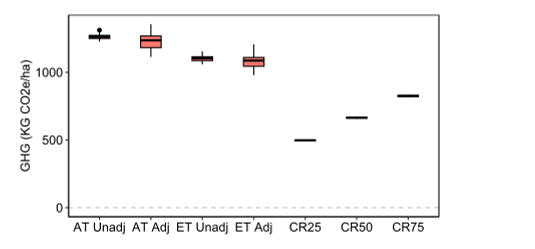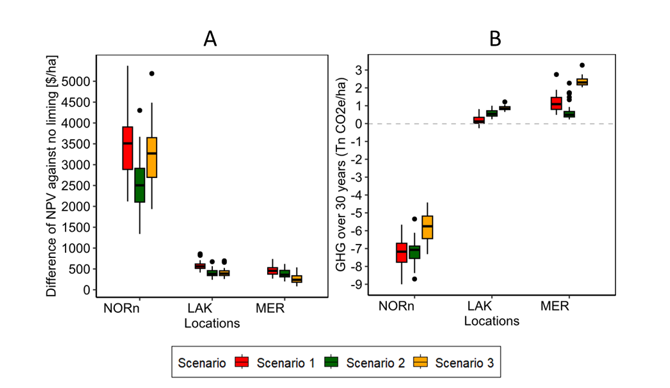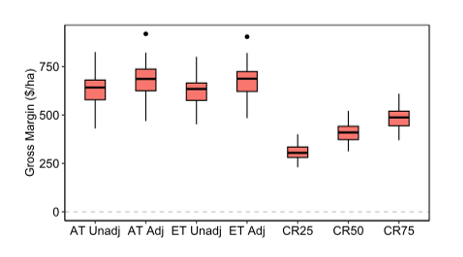Emissions and profitability: how do nitrogen and lime affect both?
Emissions and profitability: how do nitrogen and lime affect both?
Author: Sud Kharel, Christophe d’Abbadie, Amir Abadi, Ross Kingwell | Date: 27 Feb 2024
Key messages
- In-season adjustment of nitrogen can improve profitability and reduce emissions.
- Nitrogen applications for economic rather than yield maximisation can reduce emissions.
- Neglecting lime applications to reduce emissions likely reduces profit.
Introduction
Western Australian dryland cropping systems have seen a marked transition from organic N sources (including legume pasture) to an increased reliance on fertiliser use since the mid-1990s (Angus and Grace 2016). This change in practice raises environmental considerations, particularly regarding greenhouse gas emissions. Traditional farming nitrogen decision frameworks have centred on variable cost management and maximising crop revenue (Anderson et al 1998, Dillon and Anderson 1990). These approaches do not cover all environmental impacts of N usage. Present strategies adopted by Australian farmers vary, incorporating seasonal contingencies and emerging technology-driven methods.
This study aims to evaluate the economic viability of diverse N application strategies within Western Australia's varied dryland cropping systems and environments, endeavouring to identify approaches that optimise profit without escalating greenhouse gas emissions. By conducting a comprehensive analysis encompassing various locations, systems, and emissions sources, this research aims to provide robust recommendations for sustainable N application practices.
Methodology
Locations across the WA grainbelt were strategically chosen to encompass the region's diverse geographical, soil, and climatic variations. Detailed data pertaining to production inputs, crop diversity, yields, stocking rates, input expenses, revenue streams, and emission profiles for each location used in this study are documented in d’Abbadie et al (2022) and Kharel et al (2022). The economic assessment of different nitrogen and liming strategies, along with their associated emissions, drew on the Economic Valuation of Alternative Land Use Sequence (EVALUS) model (Kharel 2023). Modelling was based on 15 years of randomised weather and price data. Thirty iterations of various 15-year sequences formed the basis of modelling results.
The estimation of greenhouse gas (GHG) emissions corresponding to various scenarios relied upon the methodologies outlined in the Primary Industries Climate Change Centre's (PICCC) Sheep and Beef GHG Accounting Framework (SBGAF) and the Cropping GHG Accounting Framework (C-GAF). For a further understanding of these methodologies, refer to Ekonomou and Eckard (2022).
Nitrogen
Three N strategies, Agronomic Target (AT), Economic Target (ET), and Constant Rate (CR), were compared against a perfect knowledge strategy that yielded the highest gross margin when considering factors such as rainfall patterns, N sources, nitrogen prices, and the final grain harvest price. AT aimed to maximise yield through sufficient N application, ET aimed to maximise gross margin, and CR applied a uniform N rate annually regardless of crop potential. Additionally, the study explored adjusted (Adj) and unadjusted (Unadj) in-season N options for AT and ET strategies. In the Adjusted scenario, the model recalibrated the yield target at weeks 4 and 8 after sowing depending on the rainfall received from the time of sowing to the respective weeks. In the Unadjusted scenario, once the target yield was calculated at break of the season and the nitrogen decision was made, it was not adjusted later in the season.
Lime
Bioeconomic simulations compared farm profitability and emissions for various liming strategies over 30 years in different locations, contrasting them with a no-lime approach. The focus was on acknowledging diverse farmer goals in lime application rather than identifying the optimal liming strategy. It was assumed that the soil was responsive to liming. In the no-lime strategy, lime was not applied over the 30-year modelling period. The initial scenario included wheat, barley, and canola as a standard district practice rotation. When acidity increased by more than 40%, leading to yield reduction, canola and barley were replaced with lupin, and eventually the entire system transitioned to weedy pasture and livestock. This was compared to three liming strategies: 1) Surface lime every 3 years to maintain pH at 10–20cm depth at pH 5; 2) Application of 2 tonnes of lime whenever yield reduction due to pH reached 10%; and 3) Surface lime or deep band when pH fell below 4.8 at either level.
Results
Nitrogen
The modelling considered various locations and strategies for N application over the 15 years with changing N prices. Adjusting N application as the season progressed was found to be more profitable and less emitting than the strategy in which N was not adjusted regardless of the location. Seasonal adjustment had a high impact on both profit and emissions in northern and high-rainfall regions. This might be because the rainfall is more variable in the northern region with low soil organic carbon. Furthermore, the N inputs are higher in higher rainfall locations, so any benefits that can be obtained from adjusted N will be more valuable at these locations.
Figures 1 and 2 display results for Northampton. Results for all other locations are reported in d’Abbadie et al (2024). The difference in profitability between yield maximisation (AT) and gross margin (ET) maximisation strategies was negligible at most locations. The reason being that the ratio between the prices of wheat and N; the main determinant in ET, has been high in the data set used for analysis thus making the AT similar to ET. However, if the ratio between the prices of wheat and N decreased, the gross margin for the ET strategy would be higher than AT (Abadi and Farre 2015). The N input is lower in the ET strategy thereby generating fewer emissions.
Figure 1. Nitrogen strategy gross margins for 30 randomised selections of weather-year and price sequences at Northampton, AT: Agronomic target, ET: Economic target, CR: Constant rate Unadj: Seasonally unadjusted, Adj: Seasonally adjusted

Lime
The study demonstrated that liming consistently led to higher profitability irrespective of location or strategy (Figure 3), supporting the detrimental impact of falling pH leading to increasing aluminium availability and subsequent decreased crop production observed by Gazey and Azam (2018).
Over 30 years, it was observed in the model that increasing acidity often necessitated a shift in crop rotations from canola to lupins and volunteer pasture. This transition resulted in a shift from the highly profitable canola to less lucrative livestock. Additionally, acidic soil constrained the inclusion of break crops like canola and barley (White et al 2005) in wheat-dominant systems, leading to potentially higher weed management costs.
In medium and low-rainfall locations such as Lake Grace and Merredin, liming increased profitability, although not to the same extent as observed in Northampton. Lower fertiliser usage in regions with lower rainfall resulted in slower acidification rates, especially when starting pH levels were moderate. The effects of acidity took a longer time to manifest, and the cost of restoring the soil to its original pH after 30 years, still led to consistently higher gross margins with liming.

In Northampton, modelling revealed significantly higher emissions without liming compared to liming. The elevated fertiliser input in Northampton accelerated soil pH decline more than in Lake Grace and Merredin, prompting a quicker transition from lower-emitting crops to higher-emitting livestock. Over 30 years, total emissions in Northampton were consistently lower for all liming strategies compared to no lime. In Merredin and Lake Grace, a shift from break crops like canola and barley to the more acidic-tolerant lupin in the wheat-dominant system occurred, but the change in acidity was not rapid enough to necessitate a more drastic shift to livestock. Furthermore, as productivity decreased without lime application, N levels were adjusted to match reduced yields, resulting in a future decline in emissions.
Caveats
This paper outlines modelling outcomes that highlight the profitability of different N and lime application scenarios and their corresponding emission profiles across different locations. However, these findings may not apply to all farms within each location, as farm resources and preferences can differ. Additionally, the results do not account for potential innovative land management practices that might alter emissions and profits.
Note that the lime and N studies have been undertaken independently of each other. Further work will be undertaken to explore the relationships between liming and nitrogen management strategies.
Conclusions
Adjusting N application rates as the season progresses resulted in increased gross margins and fewer emissions. Targeting N applied for economic optimisation reduced emissions across all modelled locations.
The study found that not liming reduced the profitability in all scenarios and opting out of lime to reduce emissions lessened grain production.
Acknowledgement
This research was partly funded by the Western Australian Farming Systems project (DAW2204-003RTX), a GRDC and DPIRD co-investment.
References
Abadi A, Farre I (2015). A simple framework for profitable fertiliser use under risk and soil constraints. Australian Society of Agronomy Inc.
Anderson JR, Dillon JL, Hardaker JB (1988). Agricultural Decision Analysis. The Iowa State University Press, Ames Iowa.
Angus JF, Grace PR (2016) Nitrogen use efficiency and nitrogen balance in Australian farmlands. Paper presented to the Proceedings of the 2016 International Nitrogen Initiative Conference, "Solutions to improve nitrogen use efficiency for the world", 4 – 8 December 2016, Melbourne, Australia. https://www.publish.csiro.au/sr/SR16325
d’Abbadie, C., Kharel, S., Kingwell, R. and Abadi Ghadim, A. (2024) Profitable, low emission nitrogen application strategies in Australian dryland cropping. Crop and Pasture Science 75, CP23057 https://doi.org/10.1071/CP23057
Department of Agriculture WA (2005) Bulletin 465. Producing pulses in the southern agricultural region. Eds: White, P, Seymour, M, Burgess, P, Harries, M. (April 2005)
Dillon JL, Anderson JR (1990). The analysis of response in crop and livestock production, 3rd edition. Oxford: Pergammon Press
Ekonomou, A., Eckard, R.J., (2022). A Greenhouse Accounting Framework for crop production (G-GAF) based on the Australian National Greenhouse Gas Inventory methodology. Updated April 2022. http://www.piccc.org.au/resources/Tools
Gazey C (2017). Soil acidity in Western Australia. Department of Primary Industries and Regional Development. Soil acidity in Western Australia | Agriculture and Food
Gazey C., Azam A. (2018). Effects of soil acidity. Department of Primary Industries and Regional Development. https://www.agric.wa.gov.au/soil-acidity/effects-soil-acidity
Kharel S (2023) EVALUS user manual: first edition. Western Australian Department of Primary Industries and Regional Development, Perth. Available at http://dx.doi.org/10.13140/RG.2.2.28910.79686Kharel, S., d'Abbadie, C., Abadi, A., & Kingwell, R. 2022. Reducing farming system emissions via spatial application of payoff functions. Agricultural Systems, 203, 103534. https://doi.org/10.1016/j.agsy.2022.103534
Wang Y, Yao Z, Zhan Y, Zheng X, Zhou M, Yan G, Wang L, Werner C, Butterbach-Bahl K. Potential benefits of liming to acid soils on climate change mitigation and food security. Glob Chang Biol. 2021 Jun;27(12):2807-2821. https://doi.org/10.1111/gcb.15607. Epub 2021 Apr 9. PMID: 33742490.
GRDC Project Code: DAW2204-003RTX,

